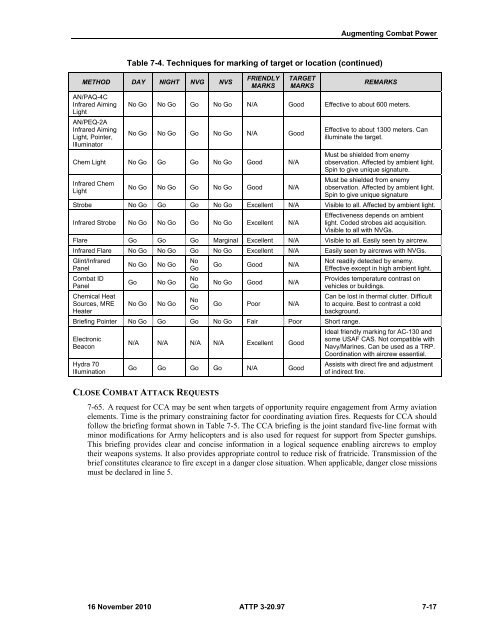Dismounted Reconnaissance Troop - Army Electronic Publications ...
Dismounted Reconnaissance Troop - Army Electronic Publications ...
Dismounted Reconnaissance Troop - Army Electronic Publications ...
You also want an ePaper? Increase the reach of your titles
YUMPU automatically turns print PDFs into web optimized ePapers that Google loves.
Table 7-4. Techniques for marking of target or location (continued)<br />
METHOD DAY NIGHT NVG NVS<br />
AN/PAQ-4C<br />
Infrared Aiming<br />
Light<br />
AN/PEQ-2A<br />
Infrared Aiming<br />
Light, Pointer,<br />
Illuminator<br />
FRIENDLY<br />
MARKS<br />
TARGET<br />
MARKS<br />
Augmenting Combat Power<br />
REMARKS<br />
No Go No Go Go No Go N/A Good Effective to about 600 meters.<br />
No Go No Go Go No Go N/A Good<br />
Chem Light No Go Go Go No Go Good N/A<br />
Infrared Chem<br />
Light<br />
No Go No Go Go No Go Good N/A<br />
Effective to about 1300 meters. Can<br />
illuminate the target.<br />
Must be shielded from enemy<br />
observation. Affected by ambient light.<br />
Spin to give unique signature.<br />
Must be shielded from enemy<br />
observation. Affected by ambient light.<br />
Spin to give unique signature<br />
Strobe No Go Go Go No Go Excellent N/A Visible to all. Affected by ambient light.<br />
Infrared Strobe No Go No Go Go No Go Excellent N/A<br />
Effectiveness depends on ambient<br />
light. Coded strobes aid acquisition.<br />
Visible to all with NVGs.<br />
Flare Go Go Go Marginal Excellent N/A Visible to all. Easily seen by aircrew.<br />
Infrared Flare No Go No Go Go No Go Excellent N/A Easily seen by aircrews with NVGs.<br />
Glint/Infrared<br />
Panel<br />
Combat ID<br />
Panel<br />
Chemical Heat<br />
Sources, MRE<br />
Heater<br />
No Go No Go<br />
Go No Go<br />
No Go No Go<br />
No<br />
Go<br />
No<br />
Go<br />
No<br />
Go<br />
Go Good N/A<br />
No Go Good N/A<br />
Go Poor N/A<br />
Briefing Pointer No Go Go Go No Go Fair Poor Short range.<br />
<strong>Electronic</strong><br />
Beacon<br />
Hydra 70<br />
Illumination<br />
N/A N/A N/A N/A Excellent Good<br />
Go Go Go Go N/A Good<br />
CLOSE COMBAT ATTACK REQUESTS<br />
Not readily detected by enemy.<br />
Effective except in high ambient light.<br />
Provides temperature contrast on<br />
vehicles or buildings.<br />
Can be lost in thermal clutter. Difficult<br />
to acquire. Best to contrast a cold<br />
background.<br />
Ideal friendly marking for AC-130 and<br />
some USAF CAS. Not compatible with<br />
Navy/Marines. Can be used as a TRP.<br />
Coordination with aircrew essential.<br />
Assists with direct fire and adjustment<br />
of indirect fire.<br />
7-65. A request for CCA may be sent when targets of opportunity require engagement from <strong>Army</strong> aviation<br />
elements. Time is the primary constraining factor for coordinating aviation fires. Requests for CCA should<br />
follow the briefing format shown in Table 7-5. The CCA briefing is the joint standard five-line format with<br />
minor modifications for <strong>Army</strong> helicopters and is also used for request for support from Specter gunships.<br />
This briefing provides clear and concise information in a logical sequence enabling aircrews to employ<br />
their weapons systems. It also provides appropriate control to reduce risk of fratricide. Transmission of the<br />
brief constitutes clearance to fire except in a danger close situation. When applicable, danger close missions<br />
must be declared in line 5.<br />
16 November 2010 ATTP 3-20.97 7-17

















